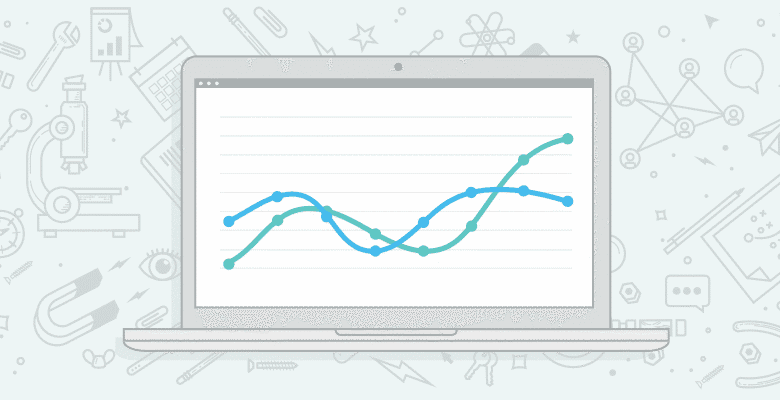
I should be eternally castigated to the fiery furnace for spoofing a Devo tune, but hopefully redemption can come in the form of this post’s value. We’ve been spending some time in analytics programs lately, both for our own in-house projects and for some clients. In every instance, the addition of action tracking makes a huge difference to how well we can optimize and make changes to internal pages and external marketing.
Action tracking is one step deeper than basics analytics – rather than simply observing what pages are visited and how many unique sessions are logged, action tracking allows you to narrow down groups of visitors by the actions they take on your site. In most instances, it requires setting up a code in your analytics program and attaching that code to a button, page load, image rollover, or other javascript-trackable task (a click or hover). Once you’ve plugged it into your analytics and the website, the action can be used to refine data you’re already collecting. I’ve created a quick example below:
![]()
You can see from the above that:
- Avatar’s Loan Form has action tracking applied to it
- Based on the people who submit loan inquiries, we can predict which search terms will be better at converting visitors into applicants
- The “revenue” column is empty, but if we were tracking e-commerce buyers, we could put their totals into those columns and track high-volume buyers
- Expanding on this idea, you could also track users by time of day, the search engine they used, their geographic location, etc.
What I’ve done in this post is to list out all of the actions that you should be tracking depending on the type of site you run. Many sites will fit into multiple criteria:
E-Commerce Site
- Add to Cart Button – studies have shown us that users who “add to cart,” even if they don’t complete checkout, are more likely to return to make a purchase. This is also a good way to calculate shopping cart abandonment and make changes to refine + improve.
- Complete Checkout – an obvious one; this action will show you what percentage of each user group is converting into sales.
- Save in Wishlist – e-commerce sites offering wish lists are still in the minority, but it’s a great way to track interest that “isn’t quite a purchase.”
- Send this to a Friend – many sites offer the “share this page” function, and it’s a great action to be aware of. If folks are sending out your link, you know you’ve got a hit.
B2B Site
- Subscribe to Newsletter – A subscription is a tacit endorsement of your brand and a desire to stay in contact. It may not be a conversion, but for B2B, it may well be the next best thing.
- Contact Form Submission – A runner-up with subscribing to a newsletter is filling out the contact form. Though some of these will be support issues, many may be questions about your products/services and will indicate a desire to open a sales conversation.
- Email Link – As with contact forms, direct email links have the possibility to be a sales contact. The best thing you can do is to clearly label sales emails and track them separately from support or business issues.
Blog
- Subscribe to RSS Feed – An RSS feed subscriber is the blog’s equivalent of a conversion; tracking these is imperative.
- Add Comment – Anyone who’s contributing content to the blog or participating should be paid attention to (as should those channels that send you participatory people)
- Social Bookmark / Share – all those folks who are submitting your content to Digg & Reddit deserve to be recognized (and sought after).
Forum or other UGC-Based Site
- Sign up for an Account – These users are active contributers; you need to know where they come from.
- Contribute Content – When a user publishes, discovering their path is important (especially if it’s not from a bookmark/type-in)
- Add Comment – As above, comments are a great predictor of engagement.
- Vote/Rate – Even low levels of participation like a rating or vote is worth tracking when every piece of participation counts.
You can get very creative with many of these and track all sorts of actions. If you offer a tool or calculator, track usage. If you want to follow who clicks a particular link (rather than just a page), add an action to it. You can even see which users hovers on an image.
For many marketers, action tracking is the secret sauce. Once you install and activate this data, even an inexperienced manager can easily make changes to an AdWords campaign or focus marketing efforts on particular terms, phrases or pages that will make a huge difference to the campaign’s efficacy. For professionals, it’s a “can’t-live-without-it” tool. The recommendations made based on this kind of track is backed up by real data. In my experience, there hasn’t been a time when a high-volume action tracking study hasn’t made a huge impact on a site’s bottom line.
I know that the following analytics services offer action tracking, though to what extent for each, I’m not certain:
- Indextools – obviously, it’s our favorite, both for its ease of use and shockingly low price. It does have some limitations, though, and isn’t quite as robust as Omniture or WebSideStory.
- WebsideStory – Along with the Omniture, it’s tops for offering the most complete package.
- Omniture – as above
- ClickTracks – a little less in-depth, but a great interface and a very usable product.
I believe there are others (though Google & Urchin are notably absent). If you’ve got suggestions for other programs that run action tracking or on how to use it, we’d love your feedback.
p.s. Come on track it. Track it good.






